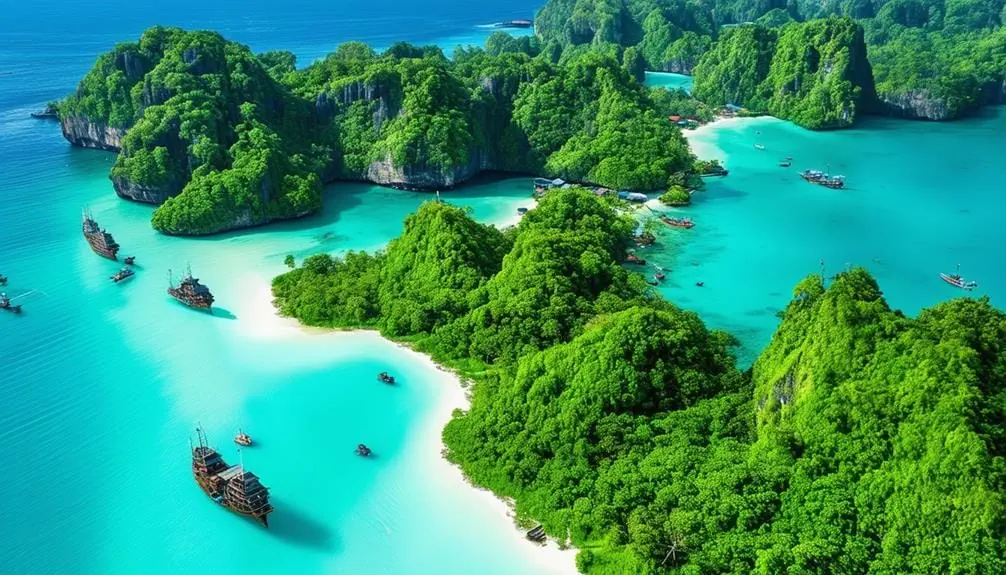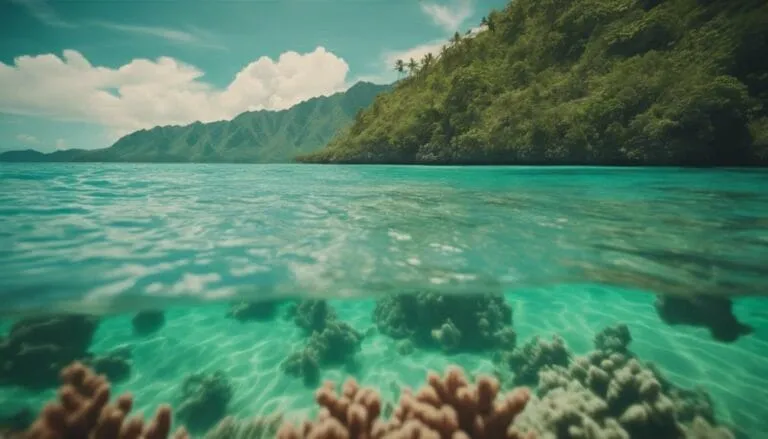Babuyan Group of Islands
Imagine you're exploring the Babuyan Group of Islands, nestled in the Luzon Strait between Luzon and Taiwan. These 24 volcanic-coralline islands, spanning around 590 km², are a blend of stunning geography and rich biodiversity. Calayan Island, the largest, is famous for the critically endangered Calayan rail. Here, the economy thrives on fishing and agriculture, with age-old traditions still alive. But what truly sets these islands apart, and how do conservation efforts navigate the geographic challenges? There's much more to uncover about this unique archipelago and its intricate balance of nature and culture.
Key Takeaways
- The Babuyan Islands comprise 24 volcanic-coralline islands located north of Luzon and south of Taiwan.
- Calayan Island is the largest and most populated island in the Babuyan Group.
- The Babuyan Islands are notable for their active volcanoes, including Smith Volcano and Didicas Volcano.
- These islands are key biodiversity areas, home to endangered species like the Calayan rail and humpback whales.
- Fishing and agriculture are the primary economic activities, with sweet potatoes as the main crop.
Geography and Location
The Babuyan Islands, a volcanic-coralline archipelago, are situated in the Luzon Strait, about 20 miles (32 km) north of Luzon and south of Taiwan. This archipelago comprises 24 volcanic-coralline islands, covering a total area of approximately 590 km² (230 sq mi). The main islands are Babuyan Claro, Babuyan, Calayan, and Dinapigue. These islands are known for their stunning natural beauty, rich marine life, and unique cultural heritage. The history of Theravada Buddhism has had a significant impact on the spiritual and religious practices of the indigenous people of the Babuyan Islands, contributing to the cultural diversity and heritage of the region.
Separated from Luzon by the Babuyan Channel and from the Batanes by the Balintang Channel, these islands form a critical ecological and geographical bridge in the region.
Calayan, the largest island, spans 196 km² (76 sq mi) and serves as the most populated and developed area within the Babuyan Islands. Here, you'll find a vibrant community that thrives amid the lush, biodiverse environment.
This island group also boasts the highest peak, Mount Pangasun, located on Babuyan Claro, which reaches an elevation of 1,108 meters (3,635 ft).
The Babuyan Islands' strategic location in the Luzon Strait means they play a significant role in regional marine biodiversity and ecological health.
The volcanic-coralline nature of these islands contributes to their unique landscapes and rich habitats, offering you a blend of freedom and natural splendor that's hard to match.
Geology and Volcanoes

Understanding the geographical significance of the Babuyan Islands enriches our appreciation of their geological foundations. Nestled within the Luzon Volcanic Arc, the Babuyan Islands owe their formation to intense volcanic activity. This archipelago is home to three historically active volcanoes: Camiguin de Babuyanes, Babuyan Claro, and Smith Volcano.
Babuyan Claro, also known as Mount Pangasun, stands as the highest peak on the islands, soaring to an elevation of 1,108 meters (3,635 feet). Didicas Volcano, a relatively recent addition, emerged dramatically from the sea floor in 1952, now towering over 200 meters (656 feet). These geological features are a demonstration of the dynamic processes shaping the region.
Volcanic landforms and coralline structures define the islands' unique topography. The intersection of these geological features and volcanic activity fosters an environment rich in biodiversity.
As you explore the Babuyan Islands, you're not just witnessing rugged beauty but also a dynamic landscape where geological forces continuously sculpt the terrain.
Flora and Fauna

Amidst the Babuyan Islands' geological marvels, you'll find a fascinating array of flora and fauna, underscoring the archipelago's ecological significance.
The Babuyan Islands, classified as key biodiversity areas by Haribon Foundation and BirdLife International, boast an exceptional array of endemic species that have evolved in isolation. These include the Babuyan flying fox, the Babuyan monitor lizard, and the Babuyan tarictic hornbill, all of which are found only on these islands. The Babuyan Islands are also home to a rich cultural heritage, with a mix of indigenous and Filipino influences. The traditional way of life in the Babuyan Islands reflects a deep connection to the natural environment and is influenced by Thailand’s cultural customs.
You'll encounter the critically endangered Calayan rail, exclusive to Calayan Island, a demonstration of the islands' unique biodiversity. Marine biodiversity thrives as well, with the islands serving as a essential congregation site for endangered humpback whales.
These facts highlight the ecological importance of the Babuyan Islands, urging ongoing conservation efforts.
Key points to note:
- Endemic Species: Many species here are found nowhere else, underscoring the islands' biodiversity.
- Calayan Rail: This critically endangered bird is a focal point for conservation.
- Marine Biodiversity: The area is crucial for humpback whales, enhancing its ecological significance.
- Unique Flora: The isolation has led to the development of rare plant species.
- Conservation Efforts: Initiatives aim to protect these ecosystems, with a potential for national park status and UNESCO World Heritage inclusion.
Conservation efforts are essential to maintaining the Babuyan Islands' unique ecosystems and highlighting their global ecological significance.
Demographics and Culture

Residents of the Babuyan Islands, numbering approximately 19,349 as of the 2020 census, form a unique demographic tapestry shaped by geographic isolation and migration patterns. Calayan Island, the most populated with 9,648 inhabitants, stands as the demographic epicenter. The community primarily consists of fishermen and farmers who rely on traditional methods for their livelihoods. Limited arable land necessitates time-honored agricultural practices, contributing to a sustainable yet modest lifestyle.
The culture of the Babuyan Islands is profoundly influenced by geographic isolation, fostering a distinct community identity. The Ivatan language, inherited from the nearby Batan Islands, is a linguistic cornerstone, reflecting the historical migration during the late 19th century when families from Batan repopulated the area. This migration has left an indelible mark on the cultural and social fabric of the islands, blending ancestral customs with local traditions.
Such demographic dynamics create a rich cultural mosaic within the broader Luzon region. The interplay of fishing, farming, and linguistic heritage underpins the community's resilience and adaptability.
You'll find that the Babuyan Islands offer a unique glimpse into how geographic isolation and migration shape both demographics and culture.
Economy and Infrastructure

The economy of the Babuyan Islands hinges primarily on fishing and agriculture, with root crops like sweet potatoes standing out as the chief agricultural yield due to the scarcity of arable land.
Fishing remains the economic cornerstone, providing essential sustenance and trade goods. Calayan Island, the primary seaport, facilitates inter-island shipping and trade with Aparri and Manila, ensuring economic connectivity.
Infrastructure development faces notable geographic challenges. Local transport relies heavily on small boats and fishing vessels, which can be a constraint but also a reflection of the resourcefulness of island communities.
Typhoons frequently disrupt shipping services from September to February, impacting economic activities and local trade.
Livestock farming, including cattle, hogs, and goats, complements agriculture and fishing, contributing to the economy through both local consumption and exports of livestock and lumber.
The islands' economy is a delicate balance influenced by natural and logistical factors.
- Fishing is the main economic activity.
- Sweet potatoes are the chief agricultural product.
- Calayan Island is vital for trade and shipping.
- Livestock farming greatly boosts the economy.
- Typhoons disrupt economic activities annually.
Frequently Asked Questions
Is Babuyan Island Part of Batanes?
No, Babuyan Island isn't part of Batanes. Babuyan geography and culture are distinct, with unique wildlife, history, tourism, and climate. Babuyan's economy, transportation, traditions, and festivals differ markedly, emphasizing its separate identity.
Who Owns Babuyan Island?
You'd find that Babuyan Island is managed by the local municipality. Its history significance, rich cultural heritage, and wildlife diversity boost tourism potential. Environmental conservation, local cuisine, and community traditions enhance its economic development and transportation access.
What Language Is Spoken in Babuyan Island?
You'll find that the primary language spoken is Ivatan, enriched by local dialects. This Chabacano dialect showcases linguistic diversity, with dialect variations influenced by cultural heritage. Effective language preservation and education maintain these indigenous languages and unique communication styles.
Are There People Living in Babuyan Island?
Yes, you'll find a thriving community on Babuyan Island. Residents engage in fishing practices and uphold rich community traditions. Despite limited arable land, their economic activities include farming. Local culture, historical significance, and unique culinary specialties enrich life here.
Conclusion
You've explored the Babuyan Group of Islands' unique geographical features, volcanic origins, and extraordinary biodiversity. With critically endangered species like the Calayan rail, these islands need your attention for conservation. Traditional fishing and agriculture form the backbone of the local economy, yet they face ecological threats. By understanding and respecting their delicate ecosystems, you can help guarantee that these vibrant islands continue to thrive amidst geographic and environmental challenges. Your engagement is crucial for their preservation.







